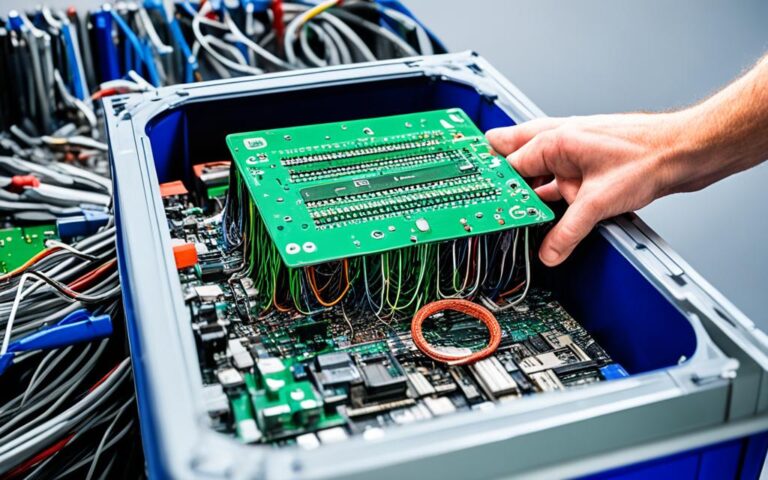Data Destruction in the Defense Sector: Special Considerations
In today’s digital era, data security is of paramount importance, particularly in the defense sector. The UK’s defense industry, characterized by stringent regulations and high stakes, requires secure data destruction protocols to safeguard sensitive information and maintain national security.
Effective execution of data destruction procedures is crucial for protecting data privacy and achieving compliance in the defense sector. Organizations operating in this industry must adhere to specialized data destruction standards, such as the US DoD 5220.22M, Air Force System Security Instruction 5020, and NSA 130-1. These standards provide guidelines for securely destroying data on various storage media, including modern storage devices like solid-state drives and hybrid drives.
Compliance with sectoral regulations and data security standards is essential for defense organizations. Data destruction plays a pivotal role in attaining compliance and ensuring the protection of sensitive information. In this article, we will explore the importance of data destruction standards in the defense sector, the methods and techniques employed, and the impact of data breaches on the sector’s security.
Importance of Data Destruction Standards in the Defense Sector
Data destruction standards are of utmost importance in the defense sector as they ensure compliance with sectoral regulations and data security standards. These standards have been followed by defense departments and security services, such as the United States Army, Navy, Air Force, and NSA, for decades.
Some prominent data destruction standards in the defense sector include US DoD 5220.22M, Air Force System Security Instruction 5020, and NSA 130-1. These standards provide comprehensive guidelines for the proper destruction of data on various storage media.
With the evolution of modern storage media, such as solid-state drives and hybrid drives, the defense sector has transitioned to effective media sanitization guidelines such as NIST SP 800-88. These guidelines ensure the secure destruction of data stored on these advanced storage devices.
By adhering to data destruction standards, the defense sector can uphold compliance with regulations, protect sensitive information, and enhance data security.
In order to prevent unauthorized access to sensitive data and safeguard national security, it is crucial for defense organizations to implement robust data destruction protocols that align with established standards.
“Data destruction standards in the defense sector are not just a matter of compliance, they are essential for protecting national security and preventing data breaches.”
These stringent standards and guidelines provide a framework for defense organizations to effectively destroy data, ensuring that it cannot be recovered or misused. By following these standards, the defense sector can maintain the highest level of data security and protect confidential information.
Compliance and Data Security
Compliance with data destruction standards is critical for defense organizations, as it helps to establish a culture of data security and protect against potential breaches. Adhering to these standards not only prevents sensitive information from falling into the wrong hands but also safeguards military strategies, intelligence, and other crucial data.
Effective data destruction methods, as prescribed by these standards, play a vital role in mitigating the risks associated with unauthorized access and data breaches in the defense sector.
The Role of Media Sanitization Guidelines
The defense sector’s adoption of media sanitization guidelines, such as NIST SP 800-88, is a response to the proliferation of advanced storage media. These guidelines provide specific techniques and procedures to securely erase data from solid-state drives (SSDs) and hybrid drives.
By following these guidelines, defense organizations can ensure that sensitive data stored on these modern storage devices is completely and irrecoverably destroyed, safeguarding against potential breaches and unauthorized access.
Data Destruction Methods and Techniques in the Defense Sector
In the defense sector, various data destruction methods and techniques are employed to ensure the secure destruction of data. These methods play a critical role in safeguarding sensitive information from falling into the wrong hands and are essential for maintaining data security in high-stakes environments.
One commonly used method in the defense sector is shredding, which involves physically destroying storage media, such as hard drives or tapes, into small pieces. This method renders the data irretrievable and eliminates the risk of unauthorized access.
Incineration is another effective method employed in the defense sector. It involves subjecting storage media to high temperatures, melting them down to complete destruction. This ensures that no trace of data remains, providing an additional layer of security.
Additionally, degaussing is a popular method used to erase data from magnetic storage media. It involves exposing the media to a strong magnetic field, effectively neutralizing the magnetic properties and rendering the data unreadable.
Furthermore, data erasure techniques are widely utilized in the defense sector. These techniques involve securely overwriting data on storage media, eliminating all traces of the original information. Advanced algorithms are used to overwrite the data multiple times, making recovery virtually impossible.
Media sanitization guidelines, such as NIST SP 800-88, provide standardized implementation methods for these data destruction techniques in the defense sector. These guidelines ensure that organizations follow a consistent approach when handling and disposing of sensitive information.
| Data Destruction Method | Description |
|---|---|
| Shredding | Physical destruction of storage media into small pieces. |
| Incineration | Subjecting storage media to high temperatures to melt them down. |
| Degaussing | Exposing magnetic storage media to a strong magnetic field to erase data. |
| Data Erasure | Securely overwriting data on storage media to eliminate traces. |
It’s worth noting that defense organizations in the UK follow the HMG IS5, which is the British Government’s data destruction standard. This standard ensures that the defense sector adheres to the highest levels of data security and compliance in data destruction practices.
The Impact of Data Breaches in the Defense Sector
Data breaches in the defense sector can have far-reaching implications, posing serious threats to data security and potentially compromising national security. Organizations in the defense sector must prioritize data breach prevention to safeguard sensitive information.
A recent study revealed that data breaches cost businesses in the defense sector an average of $4.24 million in 2021 alone. These incidents can lead to financial losses, reputational damage, and significant disruptions in operations.
Furthermore, the study found that nearly 60% of chief information officers and security professionals in the defense sector reported experiencing data breaches caused by third-party service providers. This emphasizes the importance of robust data security measures throughout the supply chain.
To mitigate the risk of data breaches, it is crucial for the defense sector to implement a comprehensive and watertight strategy for secure data destruction. By adhering to industry standards and best practices, organizations can ensure that sensitive information is securely disposed of, minimizing the risk of unauthorized access and data breaches.
Data breaches in the defense sector can have severe consequences, making it imperative for organizations to prioritize data security and implement stringent measures for secure data destruction.
By emphasizing data security and implementing effective data destruction protocols, the defense sector can safeguard sensitive information, protect national security, and mitigate the severe consequences of data breaches.
| Data Breach Consequences | Average Cost in 2021 ($) |
|---|---|
| Financial losses | 4,240,000 |
| Reputational damage | 4,240,000 |
| Disruption in operations | 4,240,000 |
Conclusion
Secure data destruction is of utmost importance in the defense sector to protect data privacy, achieve compliance, and prevent data breaches. The defense industry handles sensitive information that, if compromised, could pose significant national security risks. Adopting data destruction standards such as NIST SP 800-88 and the HMG IS5 is crucial for defense organizations to establish robust data security measures.
The defense sector faces unique challenges and requirements when it comes to data destruction. The handling and disposal of sensitive information must be executed with utmost care and adherence to industry standards. By implementing effective data destruction protocols, defense organizations can mitigate data security risks, safeguard sensitive data, and preserve national security.
Ensuring defense sector data security requires a comprehensive approach that includes secure data destruction as a fundamental component. Compliance with data destruction standards, as outlined by NIST SP 800-88 and the HMG IS5, is essential in maintaining the integrity of defense industry operations. By prioritizing secure data destruction, defense organizations can protect sensitive information, achieve compliance, and enhance overall data security in the defense sector.
FAQ
Why is effective data destruction important in the defense sector?
Effective data destruction is crucial in the defense sector for protecting data privacy and achieving compliance with sectoral regulations and data security standards. It helps prevent data breaches and potential national security risks.
What are some prominent data destruction standards in the defense sector?
The defense sector follows specialized data destruction standards such as US DoD 5220.22M, Air Force System Security Instruction 5020, NSA 130-1, and the HMG IS5, which is the British Government’s data destruction standard.
What media sanitization guidelines are used in the defense sector?
The defense sector has adopted media sanitization guidelines such as NIST SP 800-88, which provide standardized implementation methods for data destruction on modern storage media like solid-state drives and hybrid drives.
What methods and techniques are employed for data destruction in the defense sector?
Various methods are used, including shredding, incineration, degaussing, and data erasure. These techniques are defined in media sanitization guidelines like NIST SP 800-88 and are specific to different types of storage media.
What are the consequences of data breaches in the defense sector?
Data breaches in the defense sector can lead to compromised data security, potential national security risks, and significant financial costs. A study found that data breaches cost businesses an average of .24 million in 2021.
How can defense organizations mitigate data security risks?
Defense organizations can mitigate data security risks by implementing secure data destruction protocols, adhering to industry standards such as NIST SP 800-88 and the HMG IS5, and ensuring a watertight strategy for data destruction to prevent data breaches and protect sensitive information.













